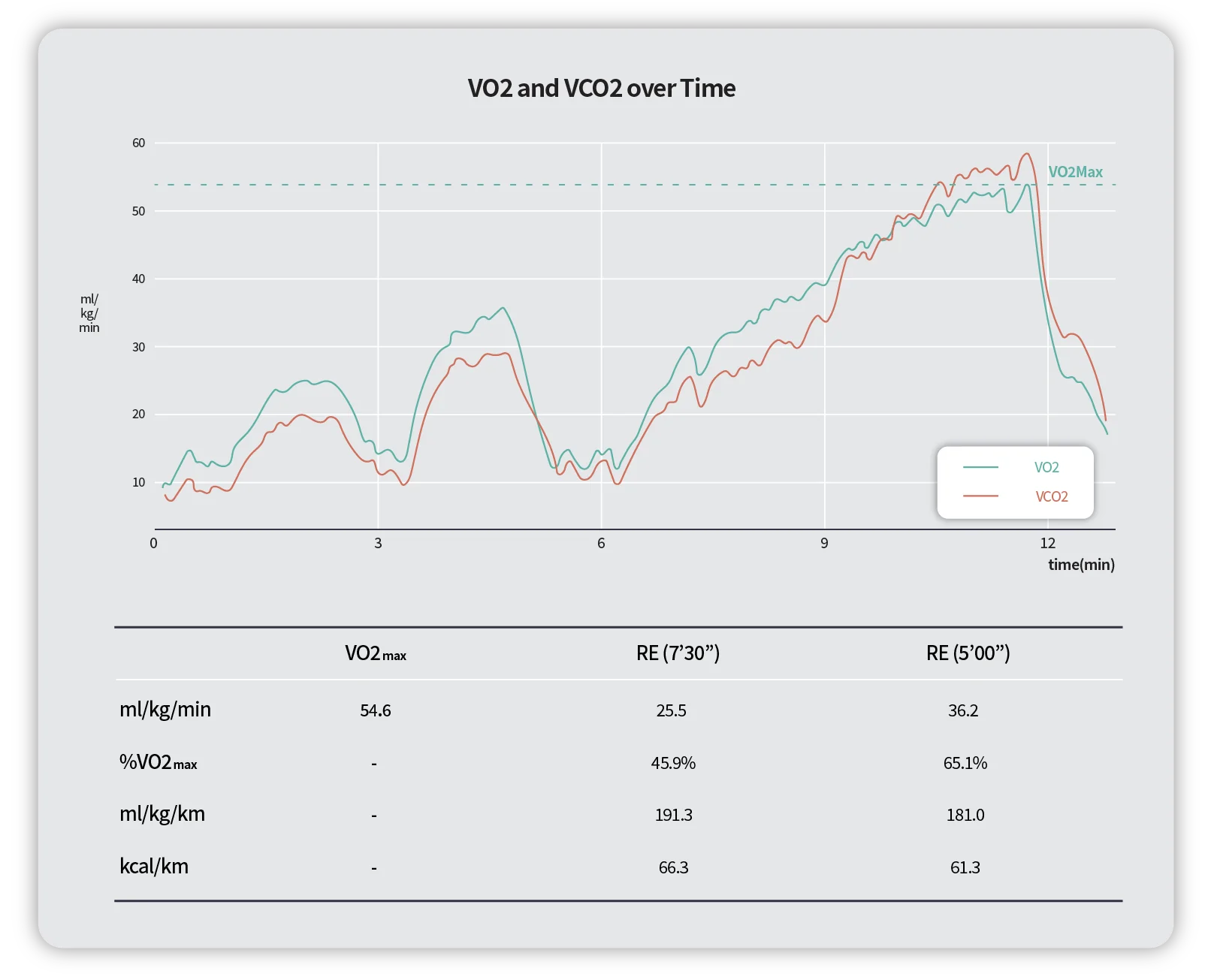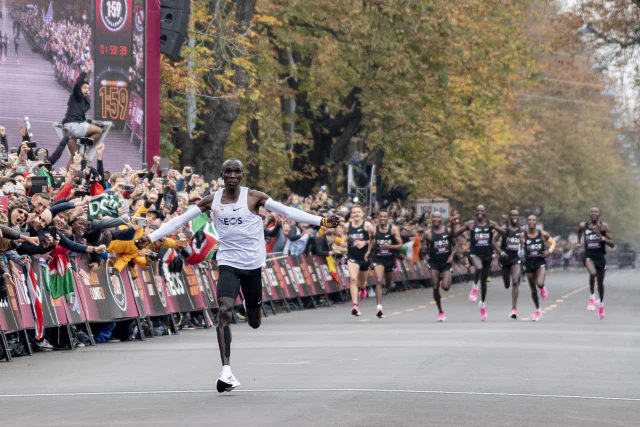
Oxygen efficiency: Running Economy
Introduction
Have you ever noticed runners who perform exceptionally well despite having relatively low lactate threshold (LT) or maximal oxygen uptake (VO₂max)? The reason might be an often-overlooked factor in running performance: Running Economy (RE). Until the mid-20th century, VO₂max was considered the primary determinant of running ability. However, researchers observed significant performance differences even among runners with similar VO₂max values. This discrepancy led to a growing interest in Running Economy from the 1980s onward.
What is Running Economy (RE)?
Running Economy (RE) refers to the amount of oxygen (or energy) required to run at a given speed. A lower oxygen consumption (VO₂) at the same speed indicates superior RE, meaning the runner is more efficient. To illustrate this concept, think of a car’s fuel efficiency. If a vehicle can travel farther or achieve higher speeds using less fuel, it has a more efficient engine. The same principle applies to the human body—if a runner requires less oxygen to sustain a given pace or can cover more distance with the same oxygen intake, they are using oxygen more efficiently. In essence, RE measures how effectively the body utilizes oxygen during running.

Measuring Running Economy
RE is typically expressed in milliliters of oxygen consumed per kilogram of body weight per minute (mL/kg/min) or per kilometer (mL/kg/km). It can also be represented in terms of energy expenditure, such as kcal/min or kcal/km. However, individual variations in VO₂max, body weight, running experience, and skill level can make direct comparisons of raw oxygen consumption misleading, even among elite athletes. Therefore, RE is often expressed as a percentage of VO₂max at a given speed. A lower percentage indicates greater efficiency, meaning the runner requires less of their VO₂max output to sustain that pace. Improving RE is crucial for endurance runners, as better efficiency translates to performance gains and delayed fatigue. Enhanced RE reduces glycogen depletion and mitigates metabolic acidosis, both of which are key factors in sustaining prolonged effort.

Factors Affecting Running Economy
Several key factors influence RE:
- Physiological Factors
- Cardiovascular function, metabolic efficiency, and muscle fiber composition all impact RE. Because RE is closely tied to oxygen utilization, the efficiency of the circulatory and respiratory systems plays a vital role. A well-developed network of mitochondria, combined with high mitochondrial enzyme activity, enhances oxygen uptake and utilization, improving RE.
- Muscle fiber type also contributes to RE. Slow-twitch (Type I) fibers, which have a higher density of capillaries and mitochondria, promote better efficiency compared to fast-twitch (Type II) fibers.
- Biomechanical Factors
- Running mechanics, such as cadence, stride length, ground contact time, and flight time, directly influence RE. Poor posture, inefficient cadence and stride length, or excessive ground contact time can lead to unnecessary energy expenditure, reducing RE. Conversely, improving neuromuscular coordination and refining running mechanics can enhance RE by minimizing wasted movement and optimizing force application.
- Consistent running practice helps refine biomechanics and increase neuromuscular efficiency, leading to improved RE over time.

- External Factors
- Environmental and equipment-related factors also play a role in RE. Running shoes, surface conditions, and weather can all influence energy expenditure. Lightweight shoes and carbon-plated footwear, for instance, have been shown to enhance RE by reducing energy loss. Similarly, running on surfaces with good energy return (e.g., polyurethane tracks) minimizes energy waste, whereas uneven terrain can increase energy demands. Extreme temperatures, whether too hot or too cold, can also affect RE due to additional energy required for thermoregulation. To accurately assess improvements in RE, measurements should be taken under consistent environmental conditions.
 Figure: EPAimages
Figure: EPAimages
Training: Secrets to Improving RE
Given the wide range of factors influencing RE, there are multiple ways to enhance it. However, one universal approach applies across all factors: consistent training. High-intensity training strengthens the respiratory and cardiovascular systems while promoting muscular adaptation. Low-intensity training enhances aerobic metabolism, increases mitochondrial function, and improves capillary density. The more a runner trains, the more neuromuscular coordination improves, and running mechanics become more refined. This principle holds even at the elite level. Paula Radcliffe, the former women's marathon world record holder, improved her RE by approximately 15% over 12 years through systematic, high-quality training. Ultimately, regardless of training intensity, the key to improving Running Economy is simple: run more. Consistent running leads to better efficiency, making you a stronger and more economical runner.
References
- Anderson, T. (1996). Biomechanics and running economy. Sports Medicine, 22(2), 76–89.
- Barnes, K. R., & Kilding, A. E. (2019). Running economy: Measurement, norms, and determining factors. Sports Medicine - Open, 5(1), 8.
- Balsalobre-Fernández, C., Santos-Concejero, J., & Grivas, G. V. (2016). Effects of strength training on running economy in highly trained runners: A systematic review with meta-analysis of controlled trials. Journal of Strength and Conditioning Research, 30(8), 2361-2368.
- Cavanagh, P. R., & Williams, K. R. (1982). The relationship of running mechanics to running economy. Journal of Biomechanics, 15(10), 837-847.
- Daniels, J. T. (1985). A physiologist’s view of running economy. Medicine and Science in Sports and Exercise, 17(3), 332-338.
- Hoogkamer, W., Kipp, S., Frank, J. H., Farina, E. M., Luo, G., & Kram, R. (2018). A comparison of the energetic cost of running in marathon racing shoes. Sports Medicine, 48(4), 1009-1019.
- Joyner, M. J., & Coyle, E. F. (2008). Endurance exercise performance: The physiology of champions. Journal of Physiology, 586(1), 35–44.
- Jones, A. M. (2006). The physiology of the world record holder for the women's marathon. International Journal of Sports Science & Coaching, 1(2), 101–116.
- Morgan, D. W., Martin, P. E., & Krahenbuhl, G. S. (1989). Factors affecting running economy. Sports Medicine, 7(5), 310–330.
- Pugh, L. G. C. E. (1970). Oxygen intake in track and treadmill running with observations on the effect of air resistance. Journal of Physiology, 207(3), 823–835.
- Saunders, P. U., Pyne, D. B., Telford, R. D., & Hawley, J. A. (2004). Factors affecting running economy in trained distance runners. Sports Medicine, 34(7), 465-485.
- Williams, K. R., & Cavanagh, P. R. (1987). Relationship between distance running mechanics, running economy, and performance. Journal of Applied Physiology, 63(3), 1236–1245.